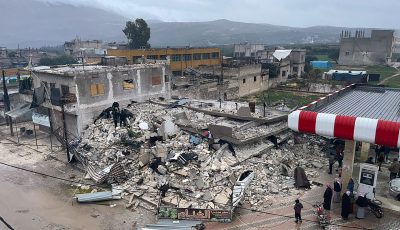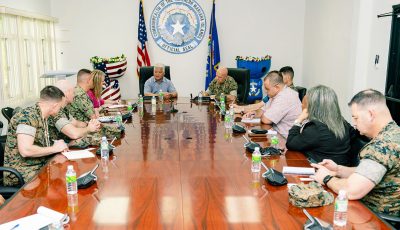100 DAYS AFTER SOUDELOR
The heroes behind EOC
For emergencies the number to call was 237-8000, and that was probably the most dialed number on Aug. 2, when Typhoon Soudelor struck Saipan.
The Emergency Operations Center on Capital Hill, manned by staff from the Homeland Security and Emergency Management as well as various government departments and agencies, was in full swing even before the typhoon made its closest approach to the island.
That Sunday evening, as the staff hunkered down to let the worst of the typhoon pass, several calls were made by residents seeking help—many of whom where panic-stricken and scared.
Despite the danger, one team went out in the middle of the typhoon to respond to a distress call—there was a bedridden patient in a house that had lost its roof.
Mark Borja was part of the response and recovery team who responded to it.
“We went to Wireless [Ridge] the back road way and it took us four hours to get into the location,” Borja said.
The team had to manually cut and clear their way to the location with chainsaws and machetes.
“The house was there but the roof flew away and there was nobody anymore,” Borja said.
He said to be out there in the dark with the strong winds blowing was scary.
“Every time the wind blows hard we hide from whatever might fall,” Borja said.
Logistics chief Eric David was another staff who had to go out the EOC building in the middle of the typhoon.
“Our roof hatch blew out. So I had to take care of that,” said David.
Around midnight, David was on the rooftop fixing the hatch to keep water and wind from going inside the building.
Being the communication specialist, David also needed to go to Mt. Tapochao to refuel the generator of their tower to make sure their radios and means of communication continued to work.
“That system went down. Our generator ran out of fuel. In the middle of the storm we had to go to Mt. Tapochao to refuel. That time was just blackout. It was very dangerous out there,” David said.
That was not the hardest part, though.
“The worst part was getting the call from my wife, crying, screaming that she needs help,” David said.
His wife was alone with their 10-year-old son and David said he couldn’t help but go home. But what is usually just a few minutes drive to their house in Koblerville took David four hours to get to. By that time, it was already daylight. Because of the devastation, roads were impassable and David had to literally make his own way home.
For David and many others like him, what added to the stress of their work was the burden of not being home with their families when the typhoon struck, as well as after Soudelor when they needed to focus on response and recovery.
After working seven days a week for months, David finally had his day off only last weekend.
Edwin Tenorio of the Department of Public Lands who was assigned to the EOC experienced the same hardship of not being with his family, especially because he hasn’t really been part of an emergency team before. Despite this, he said he felt good helping others.
“You feel good about what you’re doing,” Tenorio said.
Operations deputy section chief John San Nicolas, who is used to responding to disasters, said it was just natural for him to help.
Like San Nicolas, Naomi Ada of the planning section wasn’t also able to go home for a week after Soudelor because of the many tasks that they had to do.
Special assistant to HSEM Marvin Seman was also one of those who couldn’t get to his family when the disaster happened. His own family also had an emergency at home but he had to work and worry about the 49,000 residents he needed to look after because it was his duty.
“It was very emotional and very challenging,” Seman said.
EOC also sought the help of people from Tinian and Rota like police officer 3 Wally Villagomez and HSEM representative Vivian Hocog.
Villagomez said the experience was good training and helped him respond afterwards to Typhoon Champi when it damaged their water supply on Tinian. Hocog hopes the disaster taught people not to be complacent and to heed warnings.
Despite some criticisms and challenges, Seman said he stands by their actions and decisions.
“A lot of people were upset, a lot of people were frustrated but I am very proud of everybody that did what they did to make a difference. That’s why I’m very proud and honored to work with them. Because in less than three months, we are back on our feet,” he said.
Seman said the disaster showed him how big of a heart the community has, with ordinary people doing what they can to help each other.
“The biggest thing that I learned out of this is that we are one big-hearted community and that’s what drove me to keep things going,” Seman said.



























